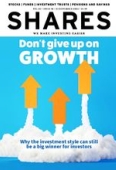Archived article
Please note that tax, investment, pension and ISA rules can change and the information and any views contained in this article may now be inaccurate.
Have investors priced in peak rates too early (again)?

The market seems to have called it – interest rates have peaked, the battle against inflation is over and we can start returning to something akin to the market conditions experienced in the decade or so before Covid when rates and prices were firmly under control.
This is a crude simplification, but the speed of the market’s recovery, with the MSCI World developed market index now close to its highest level since its most recent peak in July and up more than 9% from its late October lows, suggests a narrative along these lines is now holding sway.
Moves in the bond market have reinforced this with yields on government debt dropping as much as 0.5% from recent highs. Investors have got the ticker tape out prematurely once or twice already in the last two years – are they doing the same again? There are three key means of judging.
● What is the data telling us?
● What are central bankers saying?
● What lessons can be drawn
from history?
The latest readings of inflation on both sides of the Atlantic were notably below expectations. The annual rate of UK CPI (consumer price index) inflation for October came in at 4.6% against a forecast of 4.8%. In the Eurozone, an even lower rate of 2.9% was south of the 3.1% penciled in and in the US the CPI came in at 3.2% versus the 3.3% anticipated.
There have also been signs that tight labour market conditions – a key consideration for rate setters because continued increases in wages can lead to inflationary pressures becoming entrenched – have eased.
The latest US non-farm payroll data saw 150,000 jobs added to the economy compared with the 178,000 economists were looking for, with earnings also growing less than expected month-on-month.
However, inflation rates are still above the 2% level targeted by the Federal Reserve, Bank of England and European Central Bank, and as Rupert Thompson, chief economist at asset manager Kingswood, observes the message from officials has remained pretty consistent.
‘Central bankers are sticking to the narrative that interest rates will remain higher for longer and a further rise still cannot be ruled out,’ he says. ‘But markets are no longer listening and are now anticipating rates will start to be cut in the second quarter next year, falling by as much as 0.75% in the US, UK and Eurozone by year-end.
‘It is still quite uncertain how easy it will be and how long it will take to return inflation to this [2%] level.’ The expectation from the Fed, Bank of England and ECB is this will not be achieved until 2025.
How can we square this circle? It is at least possible investors are looking at history and have concluded it will prove hard for the central banks to hold the line on rates.
The hit to public finances from the pandemic has left governments dealing with big debt piles and they probably cannot afford to service them at current borrowing costs for too extended a period. A look back at previous rate hiking cycles suggests rates genuinely staying ‘higher for longer’ is a rare occurrence.
Important information:
These articles are provided by Shares magazine which is published by AJ Bell Media, a part of AJ Bell. Shares is not written by AJ Bell.
Shares is provided for your general information and use and is not a personal recommendation to invest. It is not intended to be relied upon by you in making or not making any investment decisions. The investments referred to in these articles will not be suitable for all investors. If in doubt please seek appropriate independent financial advice.
Investors acting on the information in these articles do so at their own risk and AJ Bell Media and its staff do not accept liability for losses suffered by investors as a result of their investment decisions.
Issue contents
Danni Hewson
Editor's View
Feature
Great Ideas
Investment Trusts
News
- NatWest retail share offer and booze duty freeze catch market attention in Autumn Statement
- Nvidia blows the lights out, but China clampdown causes concerns
- UK takeover focus turns to consumer-facing stocks
- Uber shrugs off doubts about profitability after rise in third quarter revenue
- Burberry shares suffer biggest one-day fall in over a decade
- AI-powered growth has seen Crowdstrike stock double

 magazine
magazine








